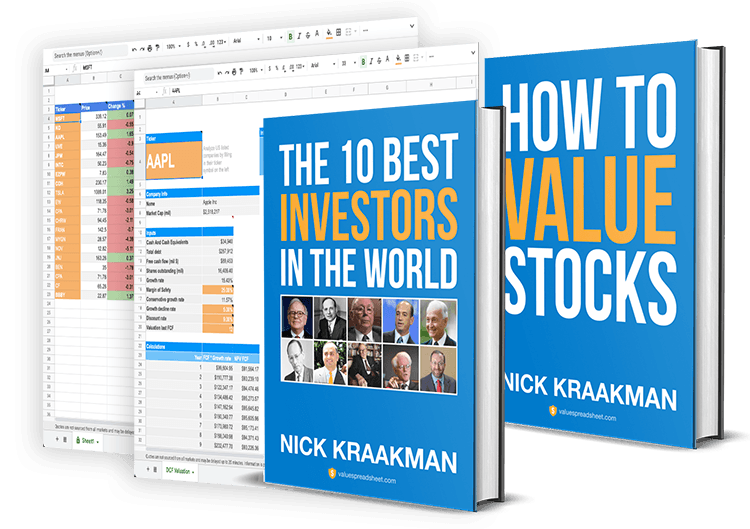Transcript
Okay guys and gals, welcome back to episode number 16 of the Value Investing Bootcamp podcast.
I'm your host, Nick Kraakman.
Before I get to the content, which is today about calculating the intrinsic or real value of a business, which is really a cornerstone of value investing, before we get to that, I first want to thank everyone again, who has been sending me their questions and their comments about the show, I really, really appreciate it.
If you have a comment or a question, the easiest way is to send me a tweet @ValueSheet, I will definitely answer all of them.
Another way, the more old fashioned way, is to send me an email at
They will come through to me and I will answer them, whatever it is, just send it to me and I'll get back to you.
So, as I said, today's topic will be about calculating the intrinsic or true value of a company.
Why is this important in the first place?
Well, as a value investor we try to buy companies that are cheap, and a company can only be cheap relative to its true value.
So, if the price... if you calculate that a company is worth, for example, $100 per share, and it's currently trading at $70 per share, it is cheap, it is at least cheaper than its value.
You can get more value for your money than when you would buy the same stock for $120, for example.
So, we are looking for bargains, and you need to know the value in order to know a bargain when you see one.
How do we do this?
Well, there is no simple way actually, that's a bit of a problem.
There are a lot of ways to calculate the intrinsic value, but none of them is perfect.
The reason for this is because they all depend, all of these valuation models depend on several assumptions, for example, about future growth rates.
Growth rate plays a big role in calculating the value of a company, because of course, the more you expect a company to grow its earnings, the more valuable this company is.
We will talk about growth rates and interest rates in upcoming episodes.
Yeah, so, several ways to calculate the company are for example, liquidation value analysis, or a discounted cash flow analysis, but also models that use their price to earnings ratio or the return on equity.
There are so many models available.
If you go to my website valuespreadsheet.com, you can actually get a free ebook which explains three separate valuation models in detail with examples and formulas, etc.
This might be useful, because of course, explaining all these numbers and calculations in an audio podcast is a bit difficult to follow, so instead I will explain the theory behind these valuation models.
For example, Warren Buffett said that the intrinsic value of a company is the present value of all the future free cash flows that a company will generate.
We already discussed free cash flow in a previous episodes; it is all the money that is left after a company paid for its expenses to stay in business, so after it is paid for its rent, for its machines, for its production capacity.
All the money that is left is called free cash flow, which is cash that can actually be taken out of the company without interfering with the company itself, it will still be able to function.
The way this works, the discounted cash flow model uses this free cash flow as an input, and then sort of projects this into the future.
This is obviously a guessing game, because it requires you to input the growth rate.
One way to get a growth rate is just look at the past couple of years, see how much the company has grown in those years, and then use that as a growth rate, or go to finance.yahoo.com where you can see analyst estimates for future growth for the coming five years, you can use that as well.
And so, you project these free cash flows into the future, and then discount them to the present, which is called a net present value analysis.
The net present value is the value of $1 in the future, in today's money.
This sounds complicated, but it is actually quite a simple concept.
If you have $1 today, it is worth more than $1 five years from now.
The reason for this is that if you have $1 today, you can invest that dollar and earn a certain interest rate on it, and so this dollar in five years, if you invest it, will be worth more than $1 in five years.
So, that is why $1 today is worth more than a $1 in the future.
And so, we have to, when we project these cash flows, these free cash flows into the future, we have to calculate their net present value, so what these future cash flows are worth today.
And if you add all of these future cash flows up, you get a value estimate.
You get an estimate of the value of the company.
This is using the discounted cash flow model.
As I said, this is explained in more detail, and probably much easier to follow if you just go to my website valuespreadsheet.com and download the free ebook.
But yeah, this is just an explanation in a very short way of how the discounted cash flow model works.
However, it is important to realize that because we make all of these assumptions, these models don't give you a perfect answer.
Sometimes they... you use a spreadsheet, for example, you get an answer, a value estimate of several decimal points, but don't put too much value in that, because you can't actually calculate the value of a company precisely.
It is always an estimate, an educated guess based on your best assumptions.
But Charlie Munger, who is Warren Buffett's business partner, he once said, “It is better to be roughly right then precisely wrong.”
So, it doesn't really matter if your intrinsic value estimates are way off.
The best way to counter this is just to use several different valuation models, and then compare the results of those models, and then lean towards the more conservative estimates.
That is really something that comes back again, and again, when you're a value investor, that you need to be conservative, in your estimates, in your predictions and your analyses.
This is the only way to protect yourself against major losses.
Always be conservative, especially when calculating the intrinsic value.
So, once you know the value, the next thing you do is simply comparing this value with the current share price.
This allows you to see if the current share price is lower than the value you calculated, which means the company is totally undervalued and might be interesting to buy at this price.
If the price is equal to value, or above the value you calculated, it is probably better to not buy this company, because it's either overvalued or fairly valued, and in both cases it means that you don't have much upside potential, so this is not an attractive investment at this price at least.
I can imagine that this explanation of this valuation model is not extremely clear, because it's just hard to convey these things with words alone.
You need to see it in front of you, see the numbers, see the formulas and calculations.
So, again, go to my website, download the ebook, check it out, and then everything should be clear.
Thanks again for listening, and I'll see you in the next episode in which we will discuss interest rates, growth rates, and discount rate.
Interesting topic, so I'll see you there!
If you enjoyed today's show, head over to ValueInvestingBootcamp.com to find out more on how you can invest like the pros, manage your own portfolio with confidence, and consistently earn mind boggling returns on the stock market.



